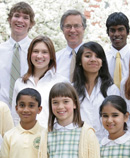
|
|
Maharishi School: Adding inner peace to the curriculum Thirty years ago two peace initiatives were born in different settings. The first occurred on September 7, 1989. In the small Midwestern town of Fairfield, Iowa, Maharishi School was founded to explore an innovative proposition. What would happen if you combined a technique for inner development—twice-daily practice of the Transcendental Meditation technique—with a rigorous college preparatory curriculum? Would inner peace lead to outer academic success and harmonious, happy students? The other peace initiative was made at the United Nations in New York City, which resolved that September 21st would hereafter be recognized as the International Day of Peace, to be celebrated with community activities around the world. Both have endured. And on September 21, 2011, they intersected. Maharishi School is no longer the only high school offering Consciousness-Based Education. The “experiment” produced such convincing results that now there are hundreds of schools worldwide where students and teachers practice the Transcendental Meditation technique to optimize brain functioning, dissolve stress, and enter the peaceful sanctuary within oneself. The International Day of Peace (IDP) has also grown. Events range from military ceasefires, volunteer clean-up projects, and living room gatherings, to celebrations in schools and organizations, all culminating in a moment of silence at 12 noon. Millions of people around the world participated at noon, including a hundred kids at Maharishi School, who know how to create peace in a stressful world. Celebrating Peace Our Way In an all-school assembly, Maharishi School celebrated its rich cultural diversity on the International Day of Peace. Students with at least one international parent submitted slides depicting the unique and colorful cultural attributes of their countries. The international students carried their national flags and greeted the assembly by saying “Hello” and “May peace prevail on earth,” in their mother tongues. The Parade of Nations included students representing 24 different countries. But, in reality, how do all these kids get along? How do they manage to survive in today’s world where 10% of all teens suffer from anxiety disorders? Are these students really peaceful? Stress in Adolescence Kids everywhere know stress. For some it’s the pressure of impossibly high expectations. Or maybe it’s a schedule jammed with activities, which keeps them short on sleep. For others it’s teen angst, trying to find oneself while struggling to find a circle of friends. And for too many, it’s the stress of a broken home or a dangerous neighborhood or the lure and loss from drug experimentation. A 2009 survey conducted by the American Psychological Association (APA) reported that 42% of teens say they get headaches due to stress, 49% report difficulty sleeping, and 39% report eating too much or too little due to stress. In Baltimore, teens were interviewed as part of a study, “Confronting Teen Stress, Meeting the Challenge in Baltimore City.” From the study, the five stressors causing the most worry included: school work (68%), parents (56%), friends’ problems (52%), romantic relationships (48%), and drugs in the neighborhood (48%). What’s a teen to do? When I talk with the students in our school, I hear a better story. They’re real kids and they know about stress. But they have a safety valve. The entire school practices the TM technique. This gives them an actual tool to dive within themselves and, at the same time, let off steam before it threatens their well-being. They know how to find peace. It's part of their curriculum. (See Excellence in Action article from 4 January, 2012).
© Copyright 2012 Global Good News®
|
|

